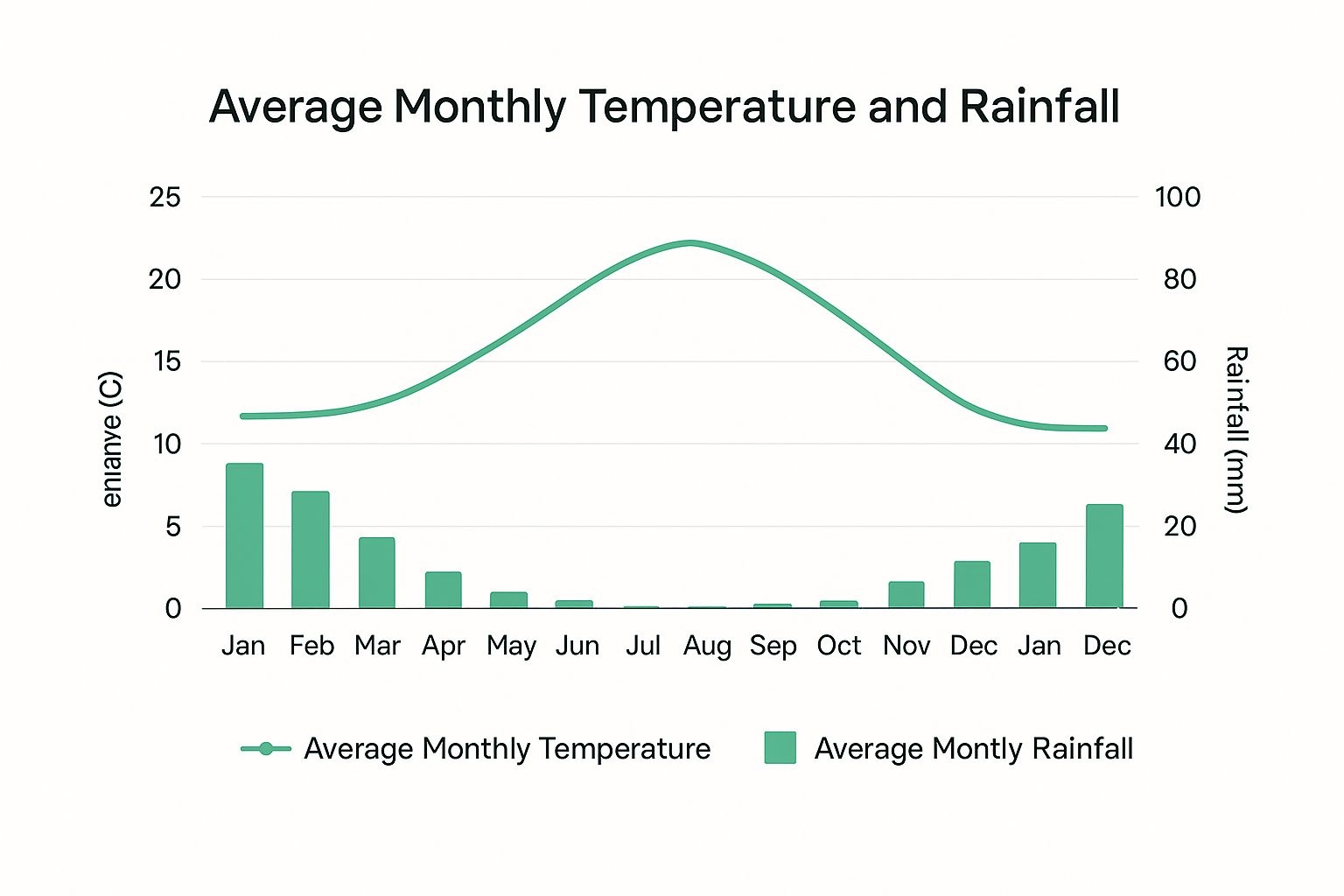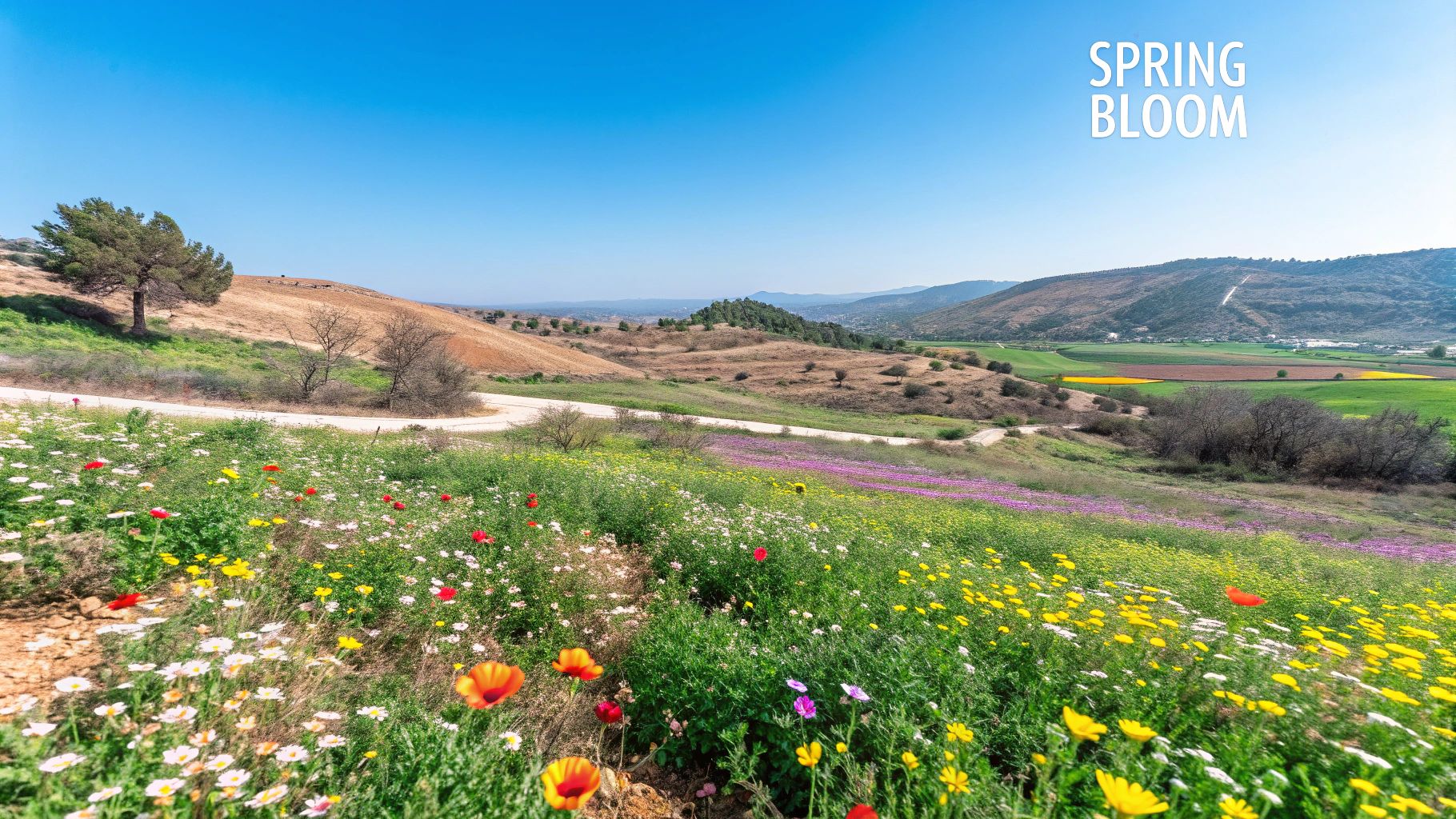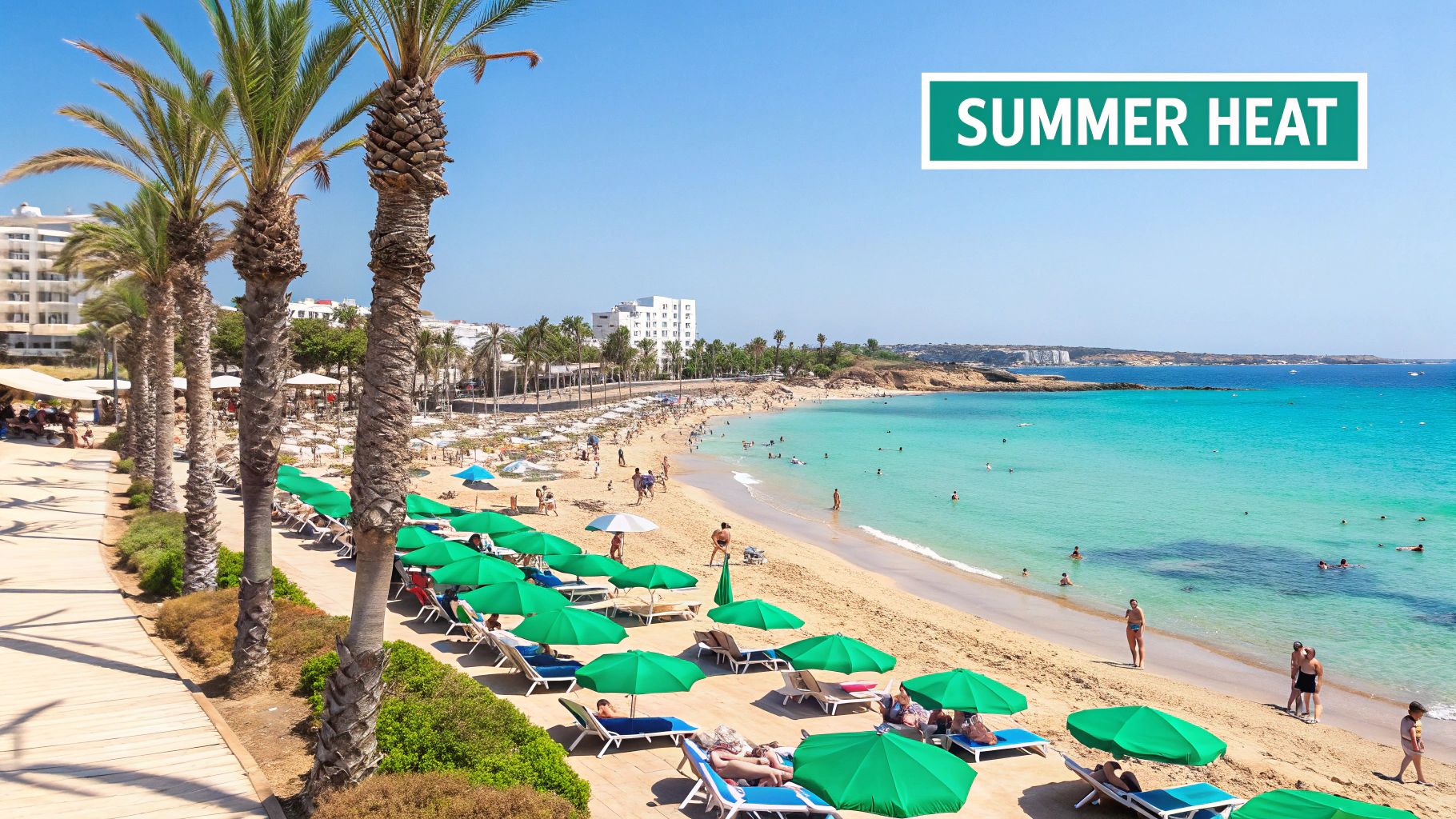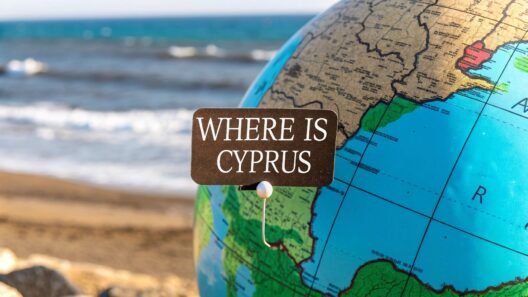Figuring out the Cyprus weather monthly is actually quite straightforward. In a nutshell, you’re looking at long, scorching, and bone-dry summers made for the beach, followed by mild, much greener winters that are perfect for getting out and exploring. With over 300 days of sunshine chalked up each year, it's one of the most reliable spots for a sunny escape.
Your Quick Guide to Cyprus Weather by Season
Before we get into the nitty-gritty of each month, it helps to get a feel for the island's rhythm through its four distinct seasons. Cyprus enjoys what’s known as a classic Mediterranean climate, a predictable pattern of hot, dry summers and gentle, wetter winters. This gives you two completely different, but equally wonderful, holiday options depending on your travel dates.
This seasonal flow is incredibly consistent. Decades of climate data show the island’s annual mean temperature sits comfortably around 17.5°C, providing a stable baseline that shifts reliably as the year progresses. If you're a real weather enthusiast, you can dive into historical climate patterns with data from sources like the Climatic Research Unit.
To make planning a bit easier, here’s a quick overview of what to expect from each season in Cyprus.
Cyprus Weather at a Glance: A Seasonal Overview
| Season | Months | Avg. High Temp (°C) | Primary Weather | Sea Condition |
|---|---|---|---|---|
| Spring | March-May | 20-25°C | Warm & sunny, little rain | Cool, then pleasantly warm |
| Summer | June-August | 30-38°C | Hot, dry, endless sun | Very warm to bath-like |
| Autumn | September-November | 22-28°C | Warm & pleasant, some rain | Warm, gradually cooling |
| Winter | December-February | 15-18°C | Mild, cooler, most rain | Chilly, for the brave only |
This table gives you a starting point, showing the clear shift from the hot, dry peak of summer to the cooler, restorative winter months.
A Tale of Two Halves: Summer vs. Winter
The best way to think about the Cypriot year is as a story in two parts. First, you have the long, sun-drenched summer, which really runs from May all the way through to October. This is when the island truly shines as a sun-worshipper’s paradise. Days are consistently hot, rain is practically unheard of, and the Mediterranean Sea turns into a warm, inviting bath perfect for swimming and watersports. It's the high-energy season, buzzing with life and ideal for that classic beach holiday or a romantic getaway. For more inspiration, have a look at our guide to planning a Cyprus honeymoon.
The second part of the story is the tranquil and mild winter, from around November to March. This period brings cooler air and the bulk of the island's annual rainfall. That rain works wonders, transforming the sun-baked summer hills into lush, green landscapes. It’s a time for cosy evenings, exploring ancient ruins without the crowds, and even hitting the ski slopes in the Troodos Mountains.
This infographic paints a very clear picture of that contrast, with temperatures soaring just as the rainfall disappears in summer.

You can see how the temperature curve shoots up from June to August, while the rainfall bars shrink to almost nothing, perfectly illustrating peak summer conditions.
Key Takeaway: The best time to visit Cyprus really comes down to what you want from your holiday. Go for summer if guaranteed sun and sea is your priority. But for comfortable exploring and seeing the island at its greenest, the shoulder seasons and winter are fantastic. Each season offers a completely different, yet equally authentic, way to experience Cyprus's charm.
Navigating the Peak Summer Heat from June to August
Welcome to the heart of a Cypriot summer. From June through to August, the island transforms into a sun-worshipper's paradise, defined by brilliant blue skies, intense sunshine, and an energy that feels like one long, warm celebration. If your perfect holiday involves cloudless days and sea temperatures that feel like a warm bath, this is absolutely your season.
The summer story truly begins in June, as the last hints of spring’s mildness fade into consistent, glorious heat. By July, the island is in full summer swing, and August stands proud as the pinnacle of the season’s warmth. During these months, rain is practically a myth; you could easily spend your entire holiday without seeing a single drop.
This period is all about embracing the heat and the vibrant lifestyle that comes with it. Resorts are buzzing, the coastline comes alive with watersports and boat trips, and the beaches are filled with people soaking up that quintessential Mediterranean sun. This is when Cyprus truly shines.
Understanding the Summer Temperatures
The heat during these months isn't just a detail; it's the main event. Daytime temperatures along the coast regularly climb into the low to mid-30s Celsius (around 90-95°F) and can easily soar higher during a heatwave. Even the evenings stay wonderfully warm and balmy, rarely dipping below 20-22°C (68-72°F), which makes dining outside under the stars a nightly ritual.
This sustained warmth is fuelled by an incredible amount of sunshine. August typically comes out on top as the hottest month, with an average high of 32°C (about 91°F) and lows that stick around 22°C (72°F). In June and July, you can expect around 12 hours of brilliant sunshine each day. To get a clearer picture of how the seasons shift, you can learn more about Cyprus's average weather patterns on WeatherSpark.
A Note on Inland Heat: While the coast gets a lovely sea breeze in the afternoon, inland cities like Nicosia get significantly hotter. It's not uncommon for temperatures there to push towards a blistering 40°C (104°F) without the cooling effect of the sea air.
What to Pack for a Summer Trip
Packing for Cyprus in summer is all about staying cool and comfortable. Your suitcase should be filled with lightweight, breathable fabrics.
- Lightweight Clothing: Think linen shirts, cotton dresses, shorts, and loose-fitting trousers. Lighter shades like whites, beiges, and pastels will feel much cooler than dark colours, which absorb the heat.
- Essential Sun Protection: This is non-negotiable. A wide-brimmed hat, high-SPF sun cream, and a good pair of sunglasses are absolute musts to shield you from the powerful sun.
- Swimwear: You'll be spending a lot of time in or near the water, so packing at least two swimsuits is a smart move.
- Evening Wear: For nights out, a light cardigan or shawl might be useful for air-conditioned restaurants, but you’ll mostly be comfortable in your summer clothes.
- Comfortable Footwear: Sandals and flip-flops are perfect for daytime. If you plan on doing some exploring, a pair of comfortable walking sandals or breathable trainers will serve you well.
Tips for Embracing the Heat Like a Local
Cypriots have perfected the art of living with the summer heat. Instead of fighting it, they adapt their daily rhythm to stay comfortable, and you can too. The trick is to work with the sun, not against it.
Plan Your Day Strategically
The sun is at its most powerful between noon and 4 pm. Locals often use this time for a long, leisurely lunch in a shaded taverna or a quick siesta.
- Morning Adventures: Plan your sightseeing or beach time for the morning, from about 9 am until noon. The sun is still strong, but the heat is more manageable.
- Late Afternoon Relaxation: Head back to the beach or the pool after 4 pm. The light softens into a beautiful golden glow, the atmosphere becomes more relaxed, and the sea feels incredibly refreshing.
Stay Hydrated the Cypriot Way
Staying hydrated is crucial, but it doesn’t have to be a chore. Why not embrace the local refreshment traditions?
- Drink Plenty of Water: It sounds simple, but always have a reusable water bottle with you.
- Enjoy a Frappé: This iconic iced coffee is a summer institution in Cyprus and the perfect afternoon pick-me-up.
- Savour Fresh Juices: Treat yourself to freshly squeezed orange or watermelon juice from a local beach bar or café. It’s pure refreshment.
By adopting these simple habits, you can fully enjoy everything a spectacular Cypriot summer has to offer, from its sun-drenched beaches to its lively, warm evenings.
Discovering Autumn's Second Summer in September and October

Just as the fierce heat of August finally begins to relent, Cyprus slides into what many of us locals lovingly call its "second summer." September and October are, without a doubt, one of the island's best-kept secrets, serving up some of the most glorious holiday weather of the entire year. It’s a time when the Cyprus weather monthly outlook reveals a perfect sweet spot—all the joys of summer, but without the intense, blistering heat.
You can almost feel the island take a collective sigh of relief. The searing midday sun softens into long, golden days of comfortable warmth. Better yet, the Mediterranean Sea, having been supercharged by the sun for months, stays wonderfully balmy and inviting. The summer crowds begin to pack up and head home, leaving the island's most stunning beaches with plenty of space just for you.
This period is an absolute dream for anyone wanting that classic sun-and-sea holiday in a more relaxed, temperate setting. The climate is simply ideal for getting out and properly exploring everything the island has to offer.
September: A Gentle Continuation of Summer
September in Cyprus doesn't really feel like autumn at all. It’s more like a gentler, more refined version of August. The sun is still out in full force, but its power has mellowed, making for perfect beach days that feel glorious from morning right through to late afternoon.
Average daytime temperatures settle in the high 20s Celsius (think 28-30°C), creating that "just right" warmth that’s brilliant for both lazing on a sunbed and a bit of sightseeing. Rain is still a rarity, with day after day of clear blue skies pretty much guaranteed. It's a fantastic choice for anyone who finds the peak summer months just a bit too much.
The sea is arguably at its absolute best in September. After months of solar heating, the water temperature often peaks at a bath-like 26-27°C. This makes it perfect for all kinds of water-based fun:
- Leisurely Swims: You can float for ages without the slightest hint of a chill.
- Snorkelling and Diving: The calm, warm waters mean visibility is outstanding for checking out the local marine life.
- Boat Trips: A day out on the water is pure bliss, with the warm air and gentle sun creating perfect conditions.
October: The Golden Month of Transition
October is when you start to notice the subtle shift towards autumn, but it’s a transition that happens in the most beautiful way. The days are still mostly warm and sunny, especially in the first half of the month, with temperatures sitting comfortably in the mid-20s (around 24-26°C).
The evenings begin to cool down ever so slightly, bringing a refreshing crispness to the air that’s wonderful for dining outside. While the chance of a short shower increases as the month wears on, these are usually brief interruptions that quickly make way for sunshine again.
Key Insight: October's comfortable climate makes it one of the best months for active exploration. The weather is fantastic for visiting ancient sites like the Tombs of the Kings or hiking the coastal paths of the Akamas Peninsula without breaking a sweat.
The sea in October remains a massive draw, holding onto its summer warmth with real dedication. Water temperatures are still a very pleasant 24-25°C, which is often warmer than the sea in the UK during its hottest summer months! This extended swimming season is a huge part of why autumn here is so cherished. The season is also ideal for shorter getaways; you can find some great inspiration in our guide to planning fantastic weekend breaks in Cyprus.
This "second summer" offers an incredible chance to experience the island's charm in a more peaceful atmosphere. With fewer people and idyllic weather, September and October truly showcase Cyprus at its most effortlessly beautiful.
When you think of winter, what comes to mind? Probably grey skies, biting winds, and maybe even snow. But winter in Cyprus? That’s a whole different story. From November through to February, the island swaps the blistering heat of summer for a gentle, restorative coolness. It's not a season to hide from; it's one to get out and embrace.
Forget the bleak, dreary days common in northern Europe. A Cypriot winter is defined by vibrant green landscapes, awakened by the first proper rains in months. After the long, sun-baked stillness of summer, the countryside springs back to life. The air feels crisp and clean, and the sun, while not as fierce, still makes plenty of welcome appearances. The Cyprus weather monthly outlook during this time offers a peaceful escape, perfect if you're after a more tranquil and authentic holiday.
This is the time of year when the island sheds its bustling tourist-season persona and shows you its quieter, more genuine side. The pace of life slows right down, the cities are far less crowded, and you get a real feel for local life. It's the perfect time for exploring ancient ruins without the queues or hiking through hills painted in vivid shades of green.

November: The Bridge Between Seasons
November is the perfect bridge month, gracefully connecting the lingering warmth of autumn with the coolness of deep winter. The first half often feels like a lovely extension of October, with plenty of bright, sunny days and daytime temperatures sitting comfortably around 20-22°C. It’s still more than pleasant enough to enjoy a coffee at a seaside café.
As the month wears on, you'll notice the shift. The evenings turn cooler, and the chances of a rain shower increase. These first rains are actually celebrated across the island, as they kick-start the island's green transformation. While it's certainly losing its summer heat, the sea is still swimmable for the brave, particularly in early November.
December and January: The Heart of Winter
December and January are what we’d call the heart of the Cypriot winter. This is when the island gets the bulk of its annual rainfall, which is absolutely vital for filling the reservoirs and nurturing the landscape for the year ahead. Even so, coastal temperatures are incredibly mild, with daytime highs usually ranging from 15-18°C. It's cool, yes, but a world away from freezing.
A Tale of Two Climates: One of the most amazing things about winter here is the island's sheer diversity. It's entirely possible to experience two completely different climates in a single day. You could wake up to a cool, crisp morning on the coast, drive up to the Troodos Mountains for a bit of skiing in the snow, and be back down by the sea for a late-afternoon walk.
The rain truly brings the countryside to life. Hills that were brown and parched in summer are suddenly carpeted in green, and the air is filled with the fresh scent of pine and damp earth. For hikers and nature lovers, this is prime time to explore the island's network of trails.
February: A Glimpse of Spring
By the time February rolls around, you can feel the first real hints of spring in the air. While it's still officially winter, the days are noticeably getting longer, and the sun feels a little warmer on your skin. The almond trees are often the first to get the memo, bursting into a stunning display of pink and white blossoms against the green hills—a beautiful sign that warmer days are just around the corner.
The rain starts to ease off, though a few showers are still common. It’s a month of beautiful contrasts: the cool air of winter mingling with the promise of spring renewal. This makes it a fantastic time for photography and quiet exploration before the crowds return.
Understanding Winter Rainfall
To truly appreciate a Cypriot winter, you need to understand the rain. It's the engine that drives the island's seasonal change. A look at the historical data shows just how concentrated this wet season is. December through February sees the most significant downpours, with monthly rainfall often topping 80 to 100 mm. This is a massive contrast to the bone-dry summer months, which often record less than 5 mm of rain. For a deeper dive, you can explore some of the hydrometeorological data for Cyprus on data.europa.eu.
To help you visualise the weather year-round, here's a detailed breakdown of the monthly averages.
Cyprus Monthly Weather Averages Detailed Breakdown
This table provides a clear overview of what to expect from the weather in Cyprus each month, from the balmy highs of summer to the mild cool of winter.
| Month | Avg. High (°C) | Avg. Low (°C) | Avg. Rainfall (mm) | Daily Sunshine (Hours) |
|---|---|---|---|---|
| January | 17 | 8 | 94 | 6 |
| February | 17 | 8 | 76 | 7 |
| March | 19 | 9 | 49 | 8 |
| April | 23 | 12 | 19 | 10 |
| May | 27 | 16 | 11 | 12 |
| June | 31 | 20 | 2 | 13 |
| July | 34 | 23 | 1 | 13 |
| August | 34 | 23 | 1 | 12 |
| September | 31 | 20 | 4 | 11 |
| October | 28 | 17 | 26 | 9 |
| November | 22 | 13 | 55 | 7 |
| December | 18 | 10 | 98 | 6 |
As you can see, even in the "wettest" months of December and January, the island still enjoys a generous amount of daily sunshine—far more than you'd find in many other parts of Europe.
What to Pack for a Winter Trip
Packing for a winter trip to Cyprus is all about smart layering.
- Light Layers: Think t-shirts, long-sleeved tops, and a few jumpers or fleeces that you can easily put on or take off.
- A Waterproof Jacket: A decent waterproof is non-negotiable for fending off those inevitable rain showers.
- Comfortable Trousers: Jeans or other comfortable trousers are perfect for daytime exploring.
- Sturdy Footwear: Waterproof walking shoes are a brilliant idea, especially if you plan on getting out into the hills.
With the right gear, you'll be perfectly comfortable and ready to enjoy everything this beautifully peaceful season has to offer, from cultural trips in quiet cities to invigorating walks through the rejuvenated countryside.
Watching the Island Bloom in Spring from March to May
After the quiet, restorative rains of winter, spring is when Cyprus truly bursts into life. From March to May, the island undergoes a spectacular transformation, shrugging off its sleepy winter mood and putting on its most dazzling natural display. If you're looking at the Cyprus weather monthly, spring offers a perfect build-up from mild and fresh to gloriously warm.
This season is a masterpiece. The air feels crisp and clean, the sun starts to find its strength again, and the entire landscape is draped in a stunning carpet of wildflowers and vibrant green. It's a time of pure energy and rebirth, making it one of the most exciting and beautiful periods to visit.
March: The First Whispers of Spring
March is a wonderful transitional month, acting as a gentle bridge between the cool winter and the reliable warmth just around the corner. You’ll notice the days getting longer and, while you might still get the odd rain shower or cooler evening, sunny days start to win the battle.
Daytime temperatures generally sit around a very pleasant 19°C, which is perfect for exploring with just a light jacket. This mild climate is an open invitation for adventure before the proper summer heat kicks in. It's ideal for tackling hiking trails in the Troodos Mountains or cycling through the rolling, green countryside.
The scenery in March is particularly stunning. Thanks to the winter rain, the fields and hillsides are positively alive with colour. Keep an eye out for brilliant yellow mustard flowers, bright red poppies, and countless other wildflowers painting the landscape.
April: A Riot of Colour and Sunshine
Come April, spring is in full, magnificent swing. The weather settles down beautifully, bringing consistent sunshine and daytime temperatures that climb into the low 20s Celsius (around 23°C). The last of the winter rain has usually moved on, leaving behind clear blue skies and an island at its absolute greenest.
This is arguably the best month for sightseeing and outdoor activities. It's warm enough for a T-shirt during the day but still cool enough that you can wander through ancient sites like the Paphos Archaeological Park or the spectacular Kourion amphitheatre without feeling overwhelmed by the heat.
Insider Tip: April is often when Cyprus celebrates Orthodox Easter. It's a deeply traditional and fascinating time to be here, filled with unique processions, family feasts, and local customs that offer a wonderful window into Cypriot culture.
The sea, which has been pretty chilly all winter, finally starts to warm up. It’s still bracing for most, but a dip in the Med on a warm April afternoon is incredibly refreshing.
May: The Arrival of Summer's Warmth
May is the month when spring gracefully passes the baton to summer. The weather is simply sublime, with long, sun-drenched days and temperatures consistently hitting a delightful 27°C or even higher. That vibrant green of early spring begins to fade into the golden tones of summer, but the island is still wonderfully lush.
This month really does offer the best of both worlds. You get the fantastic, reliable weather of summer but without the intense heat or peak-season crowds of July and August. It’s the perfect time to head to the coast and enjoy the island’s famous beaches. For some inspiration, have a look at our guide to the best Ayia Napa beaches.
The sea temperature also becomes much more inviting, typically reaching a very pleasant 20-22°C. This makes it perfect for swimming, snorkelling, and just enjoying the Mediterranean. It’s that wonderful sweet spot before the long, hot summer truly takes hold.
Common Questions About Cyprus Weather

Even after breaking down the weather month by month, you probably still have a few questions swirling around as you think about packing your bags. Getting these final details right is often what separates a good holiday from a truly great one.
This section tackles some of the most common questions we hear from travellers heading to Cyprus. Let's clear up those last few queries so you can plan your trip with complete confidence.
What Is the Best Month to Visit Cyprus for a Holiday?
This is the big one, isn't it? The truth is, there’s no single "best" month – it all comes down to what your perfect holiday looks like.
If you’re dreaming of sun-drenched beach days and warm sea swims, June and September are your sweet spots. They deliver that glorious summer feeling but sidestep the blistering heat and bustling crowds of July and August. You get all the sunshine with a little more room to breathe.
However, if you're more interested in exploring ancient ruins, hiking scenic trails, or just soaking up the culture, the shoulder months are brilliant. April, May, and October offer warm, comfortable days, perfect for being out and about. As a bonus, the island is at its most beautiful, whether it’s blanketed in spring wildflowers or glowing in the golden light of autumn.
How Cold Does It Actually Get in Cyprus During Winter?
When you compare it to a British winter, "cold" in Cyprus is a different beast entirely. Forget the need for thermal layers and de-icer, at least if you’re staying by the coast.
From December to February, the coastal cities like Paphos and Limassol enjoy daytime temperatures that hover around a very agreeable 15-18°C. It's ideal weather for a stroll along the promenade, perhaps with a light jacket.
Nights do get chilly, though, with temperatures dipping to 7-9°C, so packing a few warmer layers for the evenings is a smart move. This is also the rainiest time of year, so a waterproof jacket is non-negotiable.
The only place you'll encounter proper winter weather is high up in the Troodos Mountains. Here, temperatures often drop below freezing, blessing the peaks with enough snow for a small but lively ski season – a truly unique experience on a Mediterranean island!
Is the Sea Warm Enough to Swim in During Spring or Autumn?
Absolutely! In fact, you'll find some of the best swimming conditions of the year during these seasons. The Mediterranean has an excellent memory for heat, holding onto summer's warmth long after the air has started to cool.
Autumn is when the sea feels most luxurious. In September and October, water temperatures are fantastic, often sitting between a balmy 24°C and 26°C. It’s like slipping into a perfectly heated pool, but with far better scenery.
In spring, the sea takes a bit longer to wake up. It warms up gradually through March and April, but by late April and especially into May, it reaches a wonderfully refreshing 20-22°C. For most, it's the perfect temperature to welcome the start of the swimming season.
When Is the Windiest Time of Year in Cyprus?
Cyprus isn't a particularly windy island, but some times of the year are certainly breezier than others. You’ll notice the wind most during the transitional seasons.
As the weather patterns shift, spring (especially March and April) and autumn tend to bring stronger winds. They’re rarely disruptive, but they are a definite sign that the seasons are changing.
During the peak of summer, a delightful afternoon sea breeze, known locally as the Meltemi, often rolls in. This is a welcome visitor, acting as nature's air conditioning and taking the edge off the midday heat along the coast. While winter storms can kick up some strong gusts, wind generally isn't something you need to plan your trip around.
At SayCyprus, we believe that knowing the island’s natural rhythms is the key to an unforgettable trip. From its sun-baked shores to its peaceful mountain villages, we offer the insider knowledge you need to experience the very best of this Mediterranean gem. Explore our curated guides at https://www.saycyprus.com and start planning your perfect Cyprus adventure today.












